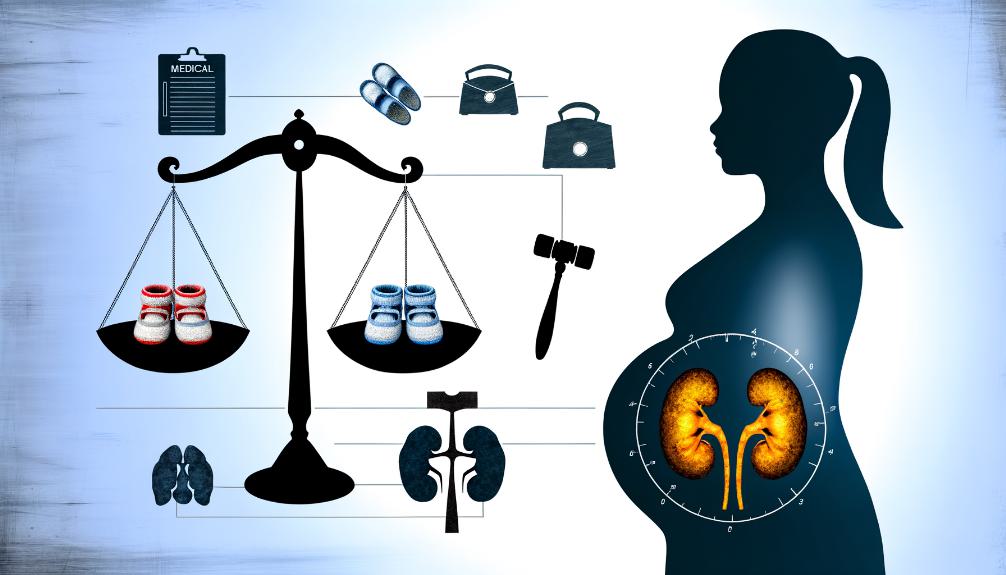Preeclampsia Risk Factors in AFFF Pregnancy Lawsuits
We've observed an intersection of risk factors in AFFF pregnancy lawsuits that's vital for understanding how preeclampsia affects expectant mothers exposed to aqueous film-forming foam. Key risk factors include low socioeconomic status, nulliparity, advanced maternal age, African American race, and in-vitro conception. These elements not only elevate the risk of preeclampsia but also complicate the legal landscape, demanding a detailed approach to liability and compensation claims. By highlighting case studies and integrating scientific evidence, we aim for a thorough strategy that supports affected families. Essentially, we're committed to working through these complexities, offering clarity and a path towards justice for our clients and enhancing comprehension of this multifaceted issue.

Key Takeaways
- AFFF exposure is linked to an elevated risk of developing preeclampsia in pregnant women.
- Risk factors like low socioeconomic status and advanced maternal age can exacerbate AFFF's effects.
- Legal cases often focus on establishing a causal relationship between AFFF exposure and preeclampsia.
- Understanding specific risk factors is crucial for tailoring legal strategies and compensation claims.
- Preventive measures, including low-dose aspirin, are important in managing preeclampsia risk among AFFF-exposed individuals.
Identifying Risk Factors

In identifying risk factors for preeclampsia in AFFF pregnancy lawsuits, we've found that factors such as low socioeconomic status, nulliparity, and advanced maternal age stand out prominently. These elements shape the landscape of litigation, pointing toward a complex interplay of biological and environmental factors that contribute to the risk. Particularly, the African American race and low socioeconomic status emerge as moderate-risk factors, underscoring the critical role that race and socioeconomic conditions play in the health outcomes of expectant mothers exposed to aqueous film-forming foam.
Moreover, in vitro conception has been identified as a moderate risk factor for preeclampsia in these cases. It's especially prevalent among women of advanced maternal age, adding another layer of complexity to evaluating risk in AFFF pregnancy lawsuits. This finding is pivotal as it highlights the nuanced ways in which reproductive technologies intersect with traditional risk factors, potentially amplifying the challenges faced by women in these circumstances.
The interconnection between race, socioeconomic status, and the prevalence of pregnancy-related hypertension in AFFF pregnancy cases cannot be overstated. These factors influence the likelihood of developing preeclampsia, an insight that is critical for legal professionals working on these lawsuits. While birth records provide a reliable capture of race information, it's important to mention that cases of in vitro conception may be underreported. This underreporting could skew the evaluation of risk factors, underscoring the necessity for thorough case review and data analysis in AFFF pregnancy lawsuits. Essentially, identifying and understanding these risk factors is crucial in building strong legal strategies and advocating for affected families.
Signs and Symptoms
Understanding the signs and symptoms of preeclampsia is vital, as they often serve as the first warning that something's not right during pregnancy. The primary indicators we're discussing include high blood pressure and protein in urine. These aren't just minor concerns; they're significant red flags that require immediate medical attention to guarantee the health and safety of both the mother and the unborn child.
When we delve deeper into the symptoms, things like severe headaches, vision changes, and upper abdominal pain can't be overlooked. They might seem somewhat common or benign in other circumstances, but during pregnancy, they could very well be indicating the presence of preeclampsia. It's not just about discomfort or temporary issues; these symptoms could suggest serious complications that demand prompt investigation.
Moreover, sudden swelling, shortness of breath, and nausea or vomiting aren't just uncomfortable symptoms; they're potentially dangerous signs that preeclampsia could be worsening. It's crucial to understand that diagnosing this condition isn't solely based on symptoms. Diagnostic tests, including blood pressure monitoring, urine analysis, and blood tests for liver and kidney function, play a vital role in confirming preeclampsia.
Treatment varies significantly depending on the severity of the condition. For mild cases, close monitoring might be adequate, but severe cases could require hospitalization and even early delivery. It's a delicate balance, ensuring the safety of the mother while also attempting to give the baby as much time as possible to develop.
Legal Framework Overview

AFFF pregnancy lawsuits' legal framework centers on holding manufacturers accountable for the health risks their products pose to pregnant women. In these lawsuits, plaintiffs argue that exposure to AFFF, a type of firefighting foam, has led to preeclampsia, a serious pregnancy complication characterized by high blood pressure and signs of damage to other organ systems. The legal claims typically focus on negligence or the failure to warn by manufacturers about the risks associated with their products during pregnancy.
We're seeing that legal actions aim to secure compensation for victims for medical expenses, pain, suffering, and other damages resulting from preeclampsia. To establish a link between AFFF exposure and preeclampsia, plaintiffs often rely on expert opinions and scientific evidence. This evidence is essential, as it helps to demonstrate the causal relationship between the chemical exposure and the onset of preeclampsia.
Navigating the legal process in these cases can be particularly challenging due to the complex litigation strategies involved. The presence of multiple parties, including large manufacturing corporations, and the need to decipher intricate scientific evidence, adds layers of complexity to these lawsuits. Additionally, proving negligence requires a thorough understanding of legal standards and how they apply to the facts of each case.
Ultimately, AFFF pregnancy lawsuits serve to highlight the importance of manufacturer accountability and the need for greater awareness and regulation concerning the health risks posed by chemical products. As we continue to monitor these cases, it's clear that the legal framework is evolving in response to emerging scientific insights and societal concerns about environmental health and safety.
Case Studies Analysis
Analyzing case studies has illuminated important risk factors for preeclampsia linked to exposure to AFFF during pregnancy. Through thorough review, it has become evident that individuals exposed to AFFF face an elevated risk of developing preeclampsia, a condition characterized by high blood pressure and often leading to severe complications for both mother and child. The data drawn from these legal proceedings underscore the critical nature of understanding how AFFF exposure intersects with preeclampsia risk factors.
In our analysis, we have observed a pattern within the case studies that consistently points to AFFF exposure as a contributing factor to the incidence of preeclampsia. This correlation is not just coincidental but is supported by evidence meticulously documented in these lawsuits. By delving into the specifics of each case, we have been able to piece together a narrative that strongly supports the theory that AFFF exposure during pregnancy elevates the risk of preeclampsia.
Furthermore, understanding these risk factors is not only vital for those affected but also plays a pivotal role in shaping legal strategies and compensation claims. Being able to demonstrate the causal relationship between AFFF exposure and the development of preeclampsia strengthens the position of plaintiffs in legal battles. This detailed examination of case studies serves as a foundation for establishing liability and pursuing justice for those impacted.
As we continue to analyze these case studies, it's imperative that we keep pushing for a deeper understanding of how AFFF exposure contributes to the risk of preeclampsia. This knowledge not only aids in legal proceedings but also underscores the importance of addressing and mitigating these risks for future pregnancies.
Preventive Measures

Having explored the link between AFFF exposure and preeclampsia risk, we'll now focus on how to prevent this condition. Preventive measures are important, especially for high-risk individuals, to mitigate the potential impacts of this serious condition. It's worth noting that low-dose aspirin (81 mg/day) is recommended for pregnant individuals at high risk for preeclampsia. This preventive strategy is supported by a grade B recommendation from the US Preventive Services Task Force (USPSTF), underscoring its significance.
Risk assessment for aspirin use considers various factors, including a history of preeclampsia or chronic hypertension. Identifying those at high risk early on to initiate preventive measures promptly is crucial. The timing and dosage of aspirin are important for its effectiveness in reducing preeclampsia risk in these populations. Adhering to proper guidelines is key for its effectiveness.
Major healthcare organizations, including the American College of Obstetricians and Gynecologists (ACOG), Society for Maternal-Fetal Medicine (SMFM), World Health Organization (WHO), and the American Heart Association/American Stroke Association (AHA/ASA), endorse aspirin intervention as a key preventive measure for preeclampsia. Their support highlights the consensus on the importance of aspirin use in preventing this condition among high-risk individuals.
Medical Misconduct
As we explore the issue of medical misconduct in AFFF pregnancy lawsuits, it's critical to highlight three main points: negligent prenatal care, misdiagnosis and delay, and inadequate treatment response. These factors often lead to severe complications for both mother and baby, underscoring the importance of holding healthcare providers accountable. By focusing on these areas, we aim to provide insights into how victims can seek justice and compensation for their suffering.
Negligent Prenatal Care
We must acknowledge that negligent prenatal care, particularly in AFFF pregnancy lawsuits, often involves the failure to adequately monitor and address important risk factors like high blood pressure, greatly heightening the risk for preeclampsia. This form of medical misconduct can lead to a lack of proper monitoring for signs of preeclampsia, such as elevated blood pressure and proteinuria. Additionally, the failure to recommend or prescribe preventative measures, like low-dose aspirin for those at high risk, represents a significant oversight. Furthermore, negligent prenatal care may result in delayed or inappropriate responses to the symptoms of preeclampsia, thereby increasing the potential for severe maternal and fetal complications. It is vital that timely interventions, including the possibility of early delivery, are not overlooked to protect both maternal and fetal well-being.
Misdiagnosis and Delay
Misdiagnosis and delays in treating preeclampsia, particularly in AFFF pregnancy lawsuits, can greatly endanger both mother and child. We've seen that misdiagnosis or the delay in diagnosing this condition can lead to severe complications, putting both lives at risk. These instances of medical misconduct often stem from healthcare providers' failure to recognize and promptly address the signs and symptoms of preeclampsia. In the context of AFFF pregnancy lawsuits, such mismanagement is a significant concern, potentially contributing to adverse outcomes and long-term health impacts for affected individuals. The failure to diagnose preeclampsia timely in these cases is a central issue in medical negligence claims, highlighting the critical need for vigilance and accuracy in prenatal care.
Inadequate Treatment Response
Inadequate treatment responses to preeclampsia not only exacerbate the risk of severe health complications but also underscore the crucial lapses in medical care standards. When healthcare providers fail to diagnose or monitor preeclampsia symptoms promptly, they're engaging in medical misconduct. This negligence can lead to dire outcomes, increasing the peril for both mother and child. It's imperative to understand that inadequate treatment response, such as delayed blood pressure management or insufficient monitoring of proteinuria, constitutes a breach of the standard care expected in managing preeclampsia. Legal actions against such negligence highlight the urgent need for healthcare professionals to recognize and address this condition without delay, preventing preventable harm and ensuring the safety of pregnant individuals and their unborn babies.
Trusting Your Attorney
In maneuvering the intricate landscape of AFFF pregnancy lawsuits, we recognize the significance of having a reliable attorney by our side. Effective communication between us and our legal representative guarantees that we're well-informed and confident in the decisions made on our behalf. Their expertise not only assists in the legal battle but also offers emotional support during this challenging time.
Attorney-Client Communication Key
We must emphasize that trusting our lawyer is fundamental to successfully managing the complexities of AFFF pregnancy lawsuits effectively. Effective attorney-client communication is vital in building this trust. It guarantees we're always on the same page regarding the progress of our case. By fostering clear and open communication, we allow ourselves to comprehend the legal process, our rights, and how our case is progressing. Trusting our attorney means sharing all relevant information, which is pivotal for evidence gathering, evaluating damages, and advocating for fair compensation. Regular updates and discussions alleviate anxiety and provide clarity, greatly strengthening our relationship with our attorney. This transparent communication is the cornerstone of handling the challenging waters of AFFF pregnancy lawsuits.
Legal Expertise Matters
Counting on an attorney with expertise in AFFF pregnancy lawsuits can greatly navigate the legal maze and enhance our chances of securing the compensation we deserve. Legal expertise is not just beneficial; it's vital for understanding the complex processes involved in preeclampsia lawsuits. Trusting a seasoned attorney means our medical records are properly evaluated, and any negligence is accurately identified. These attorneys possess a deep understanding of medical malpractice laws, guiding us through each step with valuable insight. By seeking out a lawyer specialized in preeclampsia cases linked to AFFF exposure, we're not only holding negligent parties accountable but also substantially boosting our odds for a successful legal outcome and the rightful compensation we seek.
Navigating Emotional Support
After discussing the importance of legal expertise, it's equally important to recognize how much emotional support our attorney can provide during these challenging times. Trusting our attorney is vital for receiving the emotional guidance we need throughout this complex legal process. Attorneys skilled in AFFF pregnancy cases don't just understand the law; they offer empathy, a supportive environment, and personalized attention that can greatly alleviate our stress and anxiety. This trusting relationship enhances communication, ensuring transparency and boosting our confidence in the proceedings. Our attorney's support is not just about legal advocacy; it's about providing reassurance and addressing our emotional needs as we seek justice in AFFF pregnancy lawsuits.
Future Implications
Understanding the future implications of preeclampsia risk factors in AFFF pregnancy lawsuits is essential for refining preventive strategies and enhancing patient outcomes. As we explore this topic, it's evident that the path ahead involves a thorough approach to understanding and mitigating these risks. Research into the impact of various risk factors will unquestionably shape how we approach dosing strategies and communication between patients and providers in the context of preeclampsia prevention.
Evaluating factors such as advanced maternal age and high body mass index (BMI) can help in tailoring interventions for those most at risk. Additionally, addressing the influence of race and socioeconomic status on the prevalence of preeclampsia risk factors is pivotal. This focused approach can lead to more targeted preventive measures, ensuring that interventions are equitable and accessible to all affected populations.
Exploring the progression from gestational hypertension to preeclampsia, including recurrent cases, will inform future research directions and clinical practices. This knowledge is crucial for developing interventions that not only prevent the initial onset of preeclampsia but also reduce the likelihood of recurrence in subsequent pregnancies.

This post has been generated by AI and was not reviewed by editors. This is Not legal advice. Please consult with an attorney.




